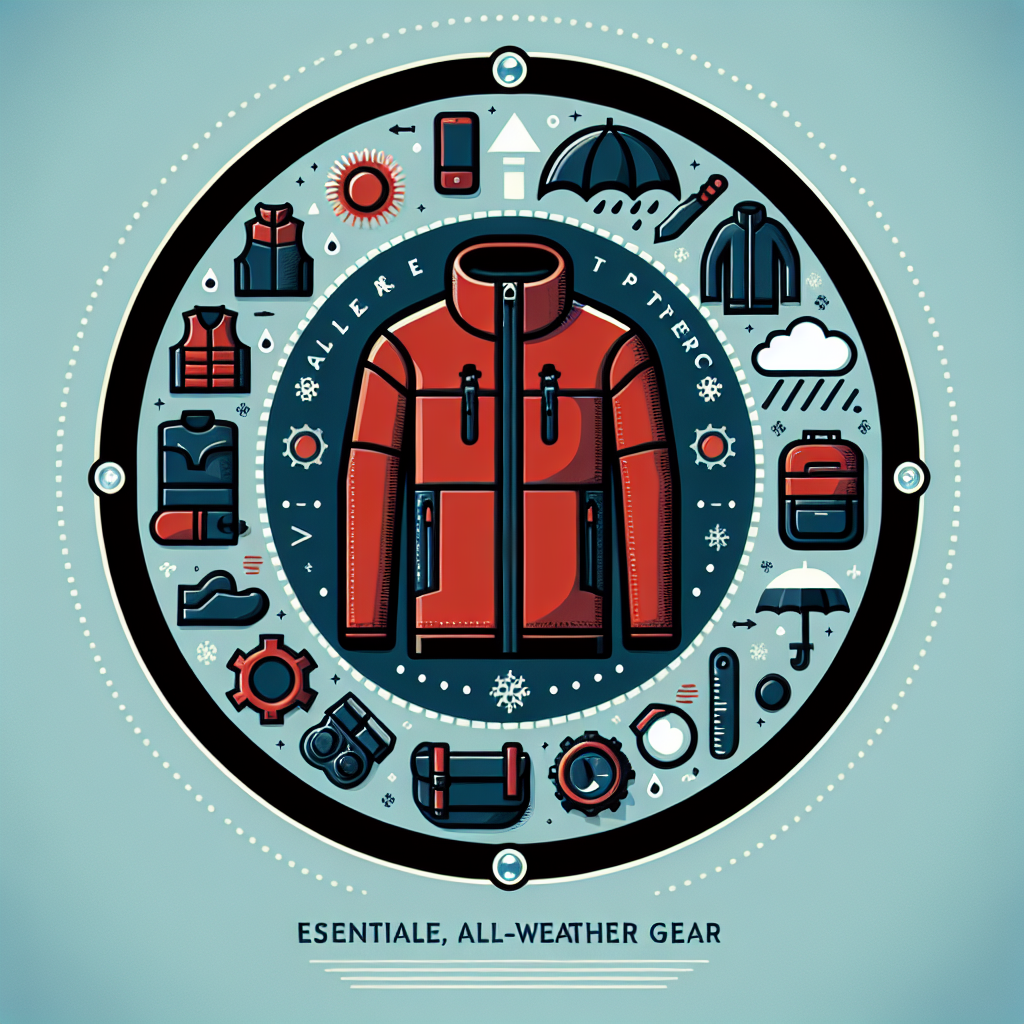Are you an avid rider who loves to hit the road no matter the weather conditions? If so, then you know the importance of having the right gear to stay comfortable and safe. From rainy days that make the roads slick, to hot sunny afternoons that leave you feeling scorched, and even snowy landscapes that transform the world into a winter wonderland, each weather condition requires its own set of gear. In this article, we will explore the essentials for riding in rain, sun, and snow, ensuring that you are well-prepared for whatever Mother Nature throws your way. So grab your helmet and let’s dive into the world of weather-appropriate gear!

Riding in Rain
Importance of Rain Gear
When it comes to riding in the rain, having the right gear is crucial. Not only does it keep you dry and comfortable, but it also ensures your safety. Riding in wet conditions can be challenging, as rain can affect visibility and make the roads slippery. Investing in proper rain gear will help you stay dry and focused, allowing you to enjoy your ride even in the wettest weather.
Waterproof Jackets
A waterproof jacket is an essential piece of gear when riding in the rain. It acts as a barrier between you and the elements, keeping you dry and protected. Look for jackets made from waterproof materials such as Gore-Tex or nylon with a waterproof coating. These jackets usually come with sealed seams to prevent water from seeping in. Additionally, consider jackets with reflective elements for increased visibility in low-light conditions.
Waterproof Pants
To keep your lower body dry while riding in the rain, waterproof pants are a must-have. Look for pants specifically designed for motorcycle riding, as they offer the necessary features to withstand the demands of the road. Waterproof pants should have a snug fit and adjustable closures at the waist and ankles to prevent water from entering. It’s also a good idea to choose pants with reinforced areas such as the knees and seat for added durability.
Waterproof Gloves
Your hands are exposed to the rain and wind while riding, making waterproof gloves an essential part of your rain gear. Look for gloves made from waterproof materials such as neoprene or Gore-Tex. These gloves should have a snug fit to ensure dexterity and allow for easy control of the bike. Consider gloves with extra padding or reinforcement in areas prone to impact, such as the knuckles, to provide added protection.
Waterproof Boots
Wet feet can quickly ruin a ride, so investing in waterproof boots is essential for riding in the rain. Look for boots specifically designed for motorcycle riding, as they provide the necessary protection and durability. Waterproof boots should be made from materials such as leather or synthetic materials with a waterproof membrane. Additionally, make sure the boots have a non-slip sole for improved grip on wet surfaces.
Rain Covers for Helmet
While a waterproof jacket and pants may protect your body, your helmet can still get wet in the rain. Using a rain cover for your helmet is an effective way to keep your head and face dry. Rain covers are usually made from waterproof materials and designed to fit snugly over your helmet, preventing water from seeping in. They often come with ventilation to ensure proper airflow and prevent fogging of the visor.
Tips for Riding in the Rain
- Reduce your speed: Wet roads can be slippery, so it’s important to reduce your speed and maintain a safe following distance.
- Stay visible: Use reflective gear and keep your headlights on to increase your visibility to other motorists.
- Brake gently: Apply the brakes gently and avoid sudden braking, as it can cause skidding on wet surfaces.
- Be cautious of painted surfaces and metal grates: These can be extra slippery when wet, so approach them with caution.
- Stay alert: Pay attention to your surroundings and anticipate potential hazards, such as puddles or decreased visibility.
Precautions to Take
- Check your tires: Ensure that your tires have sufficient tread depth and are in good condition. The right tires can provide better grip on wet roads.
- Maintain your bike: Regularly check your bike’s brakes, lights, and windshield wipers to ensure they are functioning properly.
- Choose the right lane position: Ride in the tire tracks left by cars as they can provide better traction on wet surfaces.
- Consider wearing high-visibility gear: Brightly colored gear can make you more visible to other motorists, reducing the risk of accidents.
Riding in Sun
Protective Clothing for Sun
When riding in the sun, it is essential to protect your skin from harmful UV rays. Wearing clothing that covers your arms, legs, and torso can help prevent sunburn and reduce the risk of long-term sun damage. Look for lightweight fabrics that offer UPF (Ultraviolet Protection Factor) rating for added sun protection. Long-sleeved shirts, pants, and even neck gaiters or balaclavas can provide effective coverage.
Sunscreen and Sunglasses
Even with proper clothing, it’s important to protect your exposed skin from the sun’s rays. Applying sunscreen with a high SPF (Sun Protection Factor) is crucial to prevent sunburn and reduce the risk of skin cancer. Invest in a broad-spectrum sunscreen that protects against both UVA and UVB rays. Additionally, wear sunglasses with UV protection to shield your eyes from harmful solar radiation and reduce glare.
Ventilated Helmets
Riding in the sun can be hot and uncomfortable, but a well-ventilated helmet can help dissipate heat and keep you cool. Look for helmets with plenty of vents and airflow channels to allow for proper ventilation. Some helmets even come with adjustable vents that you can open or close as needed. Good ventilation not only keeps you comfortable but also prevents fogging of the visor, ensuring clear visibility.
Head and Neck Cooling Gear
To stay cool during hot rides, consider investing in head and neck cooling gear. These accessories, such as cooling skull caps or bandanas, are designed to keep your head and neck cool by using evaporative cooling technology. Simply soak them in water for a few minutes before wearing, and they will provide hours of cooling relief. Some products also offer additional UV protection for added sun safety.
Hydration Packs
When riding in the sun, it’s crucial to stay hydrated to prevent heat exhaustion or dehydration. A hydration pack, also known as a backpack with a built-in hydration system, is a convenient way to carry water while riding. These packs usually come with a water reservoir and a drinking tube that allows you to sip water without stopping. Staying hydrated will help you stay focused and maintain your performance during long rides in the sun.
Tips for Riding in the Sun
- Plan your rides wisely: Schedule your rides during cooler parts of the day, such as early morning or late afternoon, to avoid the peak heat.
- Seek shade during breaks: When stopping for a break, find a shaded area to rest and cool down.
- Use a windshield or fairing: Installing a windshield or fairing on your bike can provide some relief from the sun and reduce wind fatigue.
- Stay cool with wet gear: If you have access to water, wetting your clothing or using wet towels can help lower your body temperature.
Precautions to Take
- Stay hydrated: Drink water regularly, even before you feel thirsty, to prevent dehydration.
- Check the weather forecast: Be aware of the day’s temperature and weather conditions to plan accordingly.
- Use proper eye protection: Wear sunglasses or a tinted visor to protect your eyes from the sun and reduce glare.
- Take breaks when needed: Listen to your body and take breaks when necessary to rest and cool down.

Riding in Snow
Importance of Snow Gear
When riding in snowy conditions, having the right gear is essential for your safety and comfort. Snow can create slippery and hazardous road conditions, so it’s crucial to invest in gear that provides proper insulation and protection against the cold. Snow gear is specially designed to keep you warm, dry, and visible while riding in wintry weather.
Insulated Jackets
An insulated jacket is a must-have when riding in the snow. Look for jackets made from waterproof and windproof materials, as well as insulated with down or synthetic insulation. These jackets should have adjustable cuffs, a high collar, and a snug fit to prevent cold air from seeping in. Additionally, consider jackets with reflective elements for increased visibility in snowy conditions.
Snow Pants
To keep your legs warm and dry while riding in the snow, invest in a pair of snow pants. Look for pants specifically designed for winter sports or motorcycle riding, as they offer the necessary features to withstand the cold and wet conditions. Snow pants should have a waterproof and windproof outer shell, as well as insulation for warmth. Adjustable waist and ankle closures are important to ensure a snug fit and prevent snow from entering.
Thermal Inner Wear
To layer up for cold rides, thermal inner wear is a great addition to your snow gear. These base layers are designed to provide insulation and moisture-wicking properties to keep you warm and dry. Look for thermal tops and bottoms made from merino wool or synthetic materials such as polyester or polypropylene. These materials effectively trap heat and wick away moisture, keeping you comfortable throughout your ride.
Heated Gloves
Keeping your hands warm is essential for maintaining proper control and dexterity while riding in the snow. Investing in heated gloves is a game-changer in cold weather. These gloves come with heating elements built into them, providing warmth to your fingers and hands. Look for gloves with adjustable heat settings and waterproof features for added functionality and protection.
Heated Boots
Cold feet can quickly ruin a ride in the snow. To combat the freezing temperatures, consider investing in heated boots. These boots have heating elements built into them, providing warmth to your feet even in the coldest conditions. Look for boots with adjustable heat settings and waterproof features to ensure both comfort and protection.
Tips for Riding in the Snow
- Reduce your speed: Snowy roads can be slippery, so it’s crucial to ride at a slower pace to ensure better traction and control.
- Increase following distance: Give yourself extra space between you and the vehicle in front to allow for safe braking and maneuvering.
- Be cautious of black ice: Black ice is a thin layer of transparent ice that can be especially hazardous. Approach shaded areas and bridges with caution.
- Stay visible: Use reflective gear and always keep your headlights on to increase your visibility in the snowy conditions.
- Avoid sudden braking or acceleration: Smooth and gentle control inputs are key to maintaining stability on snow-covered roads.
Precautions to Take
- Check your bike’s condition: Ensure that your bike is in good working condition, paying close attention to the brakes and tires, which are crucial for safe riding in the snow.
- Dress in layers: Layering your clothing allows you to adjust your body temperature throughout the ride and provides effective insulation.
- Check the weather forecast: Be aware of the snowfall amount and road conditions before heading out. Avoid riding in heavy snowstorms or blizzard-like conditions.
- Keep an emergency kit: Carry a small emergency kit with essentials such as a first aid kit, flashlight, extra gloves, and a compact snow shovel.
By having the right gear and following these tips and precautions, you can safely enjoy your rides in any weather condition, be it rain, sun, or snow. Remember, comfort and safety should always be your top priorities when hitting the road. Stay prepared, stay visible, and enjoy the ride!

